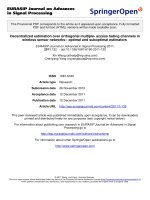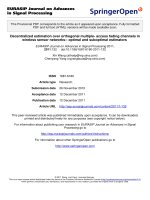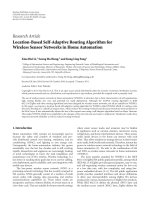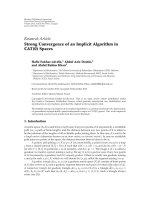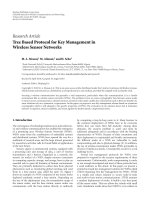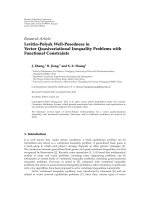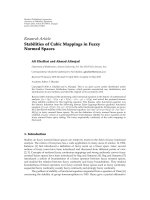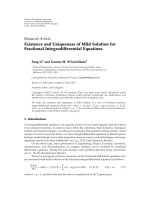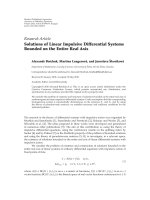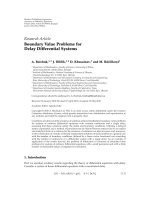Báo cáo sinh học: " Research Article Linear High-Order Distributed Average Consensus Algorithm in Wireless Sensor Networks Gang Xiong and Shalinee Kishore" doc
Bạn đang xem bản rút gọn của tài liệu. Xem và tải ngay bản đầy đủ của tài liệu tại đây (758.56 KB, 6 trang )
Hindawi Publishing Corporation
EURASIP Journal on Advances in Signal Processing
Volume 2010, Article ID 373604, 6 pages
doi:10.1155/2010/373604
Research Article
Linear High-Order Distributed Average Consensus Algorithm in
Wireless Sensor Networks
Gang Xiong and Shalinee Kishore
Department of Electrical and Computer Engineering, Lehigh University, Bethlehem, PA 18015, USA
Correspondence should be addressed to Shalinee Kishore,
Received 23 November 2009; Revised 17 March 2010; Accepted 27 May 2010
Academic Editor: Husheng Li
Copyright © 2010 G. Xiong and S. Kishore. This is an open access article distributed under the Creative Commons Attribution
License, which permits unrestricted use, distribution, and reproduction in any medium, provided the original work is properly
cited.
This paper presents a linear high-order distributed average consensus (DAC) algorithm for wireless sensor networks. The average
consensus property and the convergence rate of the high-order DAC algorithm are analyzed. In particular, the convergence rate
is determined by the spectral radius of a network topology-dependent matrix. Numerical results indicate that this simple linear
high-order DAC algorithm can accelerate the convergence without additional communication overhead and reconfiguration of
network topology.
1. Introduction
The distributed average consensus (DAC) algorithm aims
to provide distributed nodes in a network agreement on a
common measurement, known at any one node as the local
state information. As such, it has many relevant applications
in wireless sensor networks [1, 2], for example, moving-
object acquisition and tracking, habitat monitoring, recon-
naissance, and surveillance. In the DAC approach, average
consensus can be sufficiently reached within a connected
network by averaging pair-wise local state information at
networknodes.In[1], Olfati-Saber et al. established a
theoretical framework for the analysis of consensus-based
algorithms.
In this paper, we study a simple approach to improve
the convergence rate of DAC algorithms in wireless sensor
networks. The author of [3] demonstrates that the conver-
gence rate of DAC can be increased by using the “small-
world” phenomenon. This technique, however, needs to
redesign the network topology based on “random rewiring”.
In [4], an extrapolation-based DAC approach is proposed;
it utilizes a scalar epsilon algorithm to accelerate the con-
vergence rate without extra communication cost. However,
numerical results show that mean square error does not
decrease monotonically with respect to iteration time, which
may not be desirable in practical applications. In [5],
the authors extend the concept of average consensus to a
higher dimension one via the spatial point of view, where
nodes are spatially grouped into two disjoint sets: leaders
and sensors. Specifically, it is demonstrated that under
appropriate conditions, the sensors’ states converge to a
linear combination of the leaders’ states. Furthermore, multi-
objective optimization (MOP) and Pareto optimality are
utilized to solve the learning problem, where the goal is to
minimize the error between the convergence state and the
desired estimate subject to a targeted convergence rate. In
[6], the authors introduce the concept of nonlinear DAC
algorithm, where standard linear addition is replaced by a
sine operation during local state update. The convergence
rate of this nonlinear DAC algorithm is shown to be faster
under appropriate weight designs.
In this paper, we apply the principles of high-order
consensus to the distributed computation problem in wire-
less sensor networks. This simple linear high-order DAC
requires no additional communication overhead and no
reconfiguration of the network topology. Instead, it utilizes
gathered data from earlier iterations to accelerate consensus.
We study here the convergence property and convergence
rate of the high-order DAC algorithm and show that its
convergence rate is determined by the spectral radius of
2 EURASIP Journal on Advances in Signal Processing
a network topology-dependent matrix. Moreover, numerical
results indicate that the convergence rate can be greatly
improved by storing and using past data.
This paper is outlined as follows. Section 2 provides
background and system model for the high-order DAC
algorithm. Section 3 discusses convergence analysis for this
scheme. Simulation results are presented in Section 4,and
conclusions are provided in Section 5.
2. Background and System Model
2.1. Linear High-Order DAC Algorithm. We assume a syn-
chronized, time-invariant connected network. In each iter-
ation of the M-th order DAC algorithm, each node transmits
a data packet to its neighbor which contains the local state
information. Each node then processes and decodes the
received message from its neighbors. After retrieving the
state information, each node updates its local state using the
weighted average of the current state between itself and its
neighboring nodes as well as stored state information from
the M
− 1 previous iterations of the algorithm.
The update rule of the M-th order DAC algorithm at each
node i is given as
x
i
(
k
)
= x
i
(
k
− 1
)
+ ε
M−1
m=0
c
m
−
γ
m
Δx
i
(
k, m
)
,
Δx
i
(
k, m
)
=
j∈N
i
x
j
(
k
− m − 1
)
− x
i
(
k
− m − 1
)
,
(1)
where x
i
(k) is the local state at node i during iteration k;
N
i
is the set of neighboring nodes that can communicate
reliably with node i; ε is a constant step size; c
m
are predefined
constants with c
0
= 1andc
m
/
= 0(m>0); γ is a forgetting
factor, such that
|γ| < 1. We assume initial conditions of
the M-th order DAC algorithm are x
i
(−M +1) = ··· =
x
i
(−1) = x
i
(0) = θ
i
,whereθ
i
is initial local state information
for node i. It is worth mentioning that when γ
= 0, the high-
order DAC algorithm reduces to the (conventional) first-
order DAC algorithm.
This linear high-order DAC algorithm can be regarded
as a generalized version of DAC algorithm; it requires no
additional communication cost and no reconfiguration of
network topology. Compared to the conventional first-order
DAC algorithm, with negligible increase in memory size
and computation load in each sensor node, the convergence
rate can be greatly improved with appropriate algorithm
design. In [7], the authors propose an average consensus
algorithm with improved convergence rate by considering
a convex combination of conventional operation and linear
predication. In particular, a special case of one step pred-
ication is presented for detailed a nalysis. We note that the
major difference between the DAC algorithm in [7]andour
proposed scheme is that we utilize stored state difference
for high-order updating and show that optimal convergence
rate can be significantly improved by this simple extension.
Furthermore, we present explicitly the optimal convergence
rate of second-order DAC algorithm in Section 3.2.
2.2. Network Model and Some Preliminaries. In the following,
we model the wireless sensor network as an undirected graph
( The convergence properties presented here can be easily
extended for a directed graph. We omit this extension here.)
G
= (V, E), consisting of a set of N nodes V ={1, 2, , N}
and a set of edges E.Eachedgeisdenotedase = (i, j) ∈ E
where i
∈ V and j ∈ V are two nodes connected by edge e.
We assume that the presence of an edge (i, j) indicates that
nodes i and j can communicate with each other reliably. We
assume here a connected graph, that is, there exists a path
connecting any pair of distinct nodes.
Given this network model, we denote A
= [a
ij
] as the
adjacency matrix of G such that a
ij
= 1if(i, j) ∈ E
and a
ij
= 0 otherwise. Next, let L be the graph Laplacian
matrix of G which is defined as L
= D − A,whereD =
diag{d
1
, d
2
, , d
N
} is the degree matrix of G,andd
i
=|N
i
|.
Given this matrix L,wehaveL1
= 0 and 1
T
L = 0
T
,where
1
= [1, 1, ,1]
T
and 0 = [0, 0, ,0]
T
. Additionally, L is a
symmetric positive semidefinite matrix. And for a connected
graph, the rank of L is N
− 1 and its eigenvalues can be
arranged in increasing order as 0
= λ
1
(L) <λ
2
(L) ≤ ··· ≤
λ
N
(L)[8].
Let us define x(k)
= [x
1
(k), x
2
(k), , x
N
(k)]
T
.TheM-th
order DAC algorithm in (1)thusevolvesas
x
(
k
)
=
(
I
N
− εL
)
x
(
k − 1
)
− ε
M−1
m=1
c
m
−
γ
m
Lx
(
k − m − 1
)
,
(2)
with the initial conditions x(
−M +1) = ··· = x(−1) =
x(0) = θ,whereθ = [θ
1
, θ
2
, , θ
N
]
T
and I
N
denotes the
N
× N identity matrix.
3. Convergence Analysis of High-Order
DAC Algorithm
3.1. Average Conse nsus Property of High-Order DAC Algo-
rithm. Before we investigate the convergence property of
the high-order DAC algorithm, we define two MN
× MN
matrices
H
=
⎡
⎢
⎢
⎢
⎢
⎢
⎢
⎢
⎣
I
N
− εL c
1
γεL ··· −c
M−1
−γ
M−1
εL
I
N
0
N×N
··· 0
N×N
.
.
.
.
.
.
.
.
.
0
N×N
··· I
N
0
N×N
⎤
⎥
⎥
⎥
⎥
⎥
⎥
⎥
⎦
,
J
=
⎡
⎢
⎢
⎢
⎢
⎢
⎢
⎢
⎣
K 0
N×N
··· 0
N×N
K 0
N×N
··· 0
N×N
.
.
.
.
.
.
.
.
.
K 0
N×N
··· 0
N×N
⎤
⎥
⎥
⎥
⎥
⎥
⎥
⎥
⎦
,
(3)
where K
= (1/N )11
T
, and 0
N×N
denotes the N × N all-zero
matrix. Then we have the following lemma:
Lemma 1. The eige nvalues of H
− J agree with those of H
except that λ
1
(H) = 1 is replaced by λ
1
(H − J) = 0.
EURASIP Journal on Advances in Signal Processing 3
Proof. Let us define two MN
× 1vectorsh
l
= (1/N)[1
T
0
T
···0
T
]
T
and h
r
= [1
T
···1
T
1
T
]
T
. It is easy to check that h
l
and h
r
are left and right eigenvectors of H corresponding to
λ
1
(H) = 1, respectively, that is, h
T
l
H = h
T
l
and Hh
r
= h
r
.
Additionally, J
= h
r
h
T
l
, h
T
l
h
r
= h
T
l
h
l
= 1.Inordertoobtain
the eigenvalues of H
− J,wehave[9]
det
(
H
− J − λI
MN
)
= det
(
H − λI
MN
)
1 − h
T
l
(
H
− λI
MN
)
−1
h
r
=
⎡
⎣
±
MN
i=1
(
λ
i
(
H
)
− λ
)
⎤
⎦
1 −
h
T
l
h
r
1 − λ
=
⎡
⎣
±
MN
i=2
(
λ
i
(
H
)
− λ
)
⎤
⎦
(
−λ
)
.
(4)
The above equation is valid because
h
r
=
(
H
− λI
MN
)
−1
(
H
− λI
MN
)
h
r
=
(
H
− λI
MN
)
−1
(
1
− λ
)
h
r
.
(5)
Thus, the eigenvalues of H
− J are λ
1
(H − J) = 0and
λ
i
(H − J) = λ
i
(H), i = 2, , MN. This completes the proof.
The average consensus property of the M-th order
DAC algorithm in wireless sensor networks is stated in the
following theorem.
Theorem 1. Consider the M-th order DAC algorithm in
(2) in a time-invariant, connected, undirected wireless sensor
network, with initial conditions x(
−M +1)=··· =x(−1) =
x(0) = θ. When ρ(H −J) < 1,anaverageconsensusisachieved
asymptotically, or equivalently,
lim
k →∞
x
i
(
k
)
=
1
N
1
T
θ =
1
N
N
i=1
θ
i
, ∀i ∈ V,
(6)
where ρ(
·) denotes the spectral radius of a matrix.
Proof. Let us define ψ(k)
= [x(k)
T
x(k − 1)
T
···x(k − M +
1)
T
]
T
. Then, the M-th order DAC algorithm in (2)canbe
rewritten as ψ(k)
= Hψ(k − 1), which implies that ψ(k) =
H
k
ψ(0). To calculate the eigenvalues of H,wehave[9]
det
(
H
− λI
MN
)
=
N
i=1
⎛
⎝
λ
M
−
(
1
− ελ
i
(
L
))
λ
M−1
+ε
M−1
m=1
c
m
−
γ
m
λ
i
(
L
)
λ
M−1−m
⎞
⎠
=
0.
(7)
Thus, the eigenvalues of H should satisfy the following
equation:
f
(
λ
)
= λ
M
−
(
1
− ελ
i
(
L
))
λ
M−1
+ ε
M−1
m=1
c
m
−
γ
m
λ
i
(
L
)
λ
M−1−m
= 0.
(8)
Note that there are M roots corresponding to one λ
i
(L).
For a time invariant and connected network, L has only
one eigenvalue, λ
1
(L) = 0. From (8), when λ
1
(L) = 0, the
eigenvalues of H satisfy f (λ)
= λ
M
−λ
M−1
= 0. Then, for this
λ
1
(L) = 0, H has only two distinct eigenvalues, λ
1
(H) = 1
(with algebraic multiplicity 1) and λ
2
(H) = 0 (with algebraic
multiplicity M
− 1). Additionally, it is easy to show that the
algebraic multiplicity of eigenvalue λ(H)
= 1isequalto1.
Based on Lemma 1, we know that the eigenvalues of H
− J
agree with those of H except that λ
1
(H) = 1 is replaced by
λ
1
(H −J) = 0. Since ρ(H − J) < 1, we see that the eigenvalues
of H stay inside the unit circle except for λ
1
(H) = 1. Thus,
we have
lim
k →∞
H
k
= V lim
k →∞
1 0
1×(MN−1)
0
(MN−1)×1
Λ
k
V
−1
= V
1 0
1×(MN−1)
0
(MN−1)×1
0
(MN−1)×(MN−1)
V
−1
= h
r
h
T
l
,
(9)
where Λ is the Jordan form matrix corresponding to
eigenvalues λ
i
(H)
/
= 1[9]. Thus, we have lim
k →∞
H
k
= J.
Then, lim
k →∞
ψ(k) = Jψ(0), which indicates
lim
k →∞
x
i
(
k
)
=
1
N
1
T
θ.
(10)
This completes the proof.
According to Theorem 1, we see that when this linear
high-order DAC algorithm is employed in an undirected
wireless sensor network, average consensus can be achieved
asymptotically. We also note that our proposed high-order
DAC algorithm relies heavily on local state information
exchange between two or more nodes in the networks. Noisy
links [10 ] and packet drop failures [11] will certainly affect
the performance of our proposed high-order DAC algorithm.
We will investigate these important issues in the future.
3.2. Convergence Rate for High-Order DAC Algorithm. One
of the most important measures of any distributed, iterative
algorithm is its convergence rate. As we show next, the con-
vergence rate of the high-order DAC algorithm is determined
by the spectral radius of H
− J, which is similar to the first-
order DAC algorithm [1].
Let us define the average consensus value in each iteration
as m(k)
= (1/N)1
T
x(k). In the high-order DAC algorithm,
this value remains invariant during each iteration since
m
(
k
)
=
1
N
1
T
⎡
⎣
(
I
N
− εL
)
x
(
k − 1
)
−ε
M−1
m=1
c
m
−γ
m
Lx
(
k − m − 1
)
⎤
⎦
=
m
(
k − 1
)
=··· =m
(
0
)
.
(11)
We now define the disagreement vector as δ(k)
= x(k) −
m(k)1, which indicates the difference between the updated
4 EURASIP Journal on Advances in Signal Processing
1
23
456
(a)
0
0.1
0.2
0.3
0.4
0.5
0.6
0.7
0.8
0.9
1
010.10.20.30.40.50.60.70.80.9
(b)
Figure 1: Network topologies used in numerical results: (a) fixed network with 6 nodes (Case 1) and (b) random network with 16 nodes
(Case 2).
local state and the average state of the network nodes. Then,
the evolution of the disagreement vector is obtained as.
δ
(
k
)
=
(
I
N
− εL
)
δ
(
k − 1
)
− ε
M−1
m=1
c
m
−
γ
m
Lδ
(
k − m − 1
)
.
(12)
Given this dynamic of the disagreement vector, we note.
Lemma 2. For the M-th order DAC algorithm in (2) in a time
invariant, connected, undirected wireless sensor network, with
initial conditions x(
−M +1) = ··· = x(−1) = x(0) = θ
and α
= ρ(H − J) < 1, an average consensus is exponentially
reached i n the following form:
M−1
m=0
δ
(
k − m
)
2
δ
(
0
)
2
≤ Mα
2k
,
(13)
where
·denotes the
2
norm of a vector.
Proof. Let us define the error vector as e(k)
= [δ
T
(k) δ
T
(k −
1) ···δ
T
(k − M +1)]
T
which can be obtained from e(k) =
ψ(k) − J
1
ψ(k), where J
1
= I
M
⊗ K,and⊗ denotes the
Kronecker product.
Based on this definition, we see that the error vector
results in the following evolution:
e
(
k
)
=
(
H
− J
1
H
)
ψ
(
k − 1
)
=
(
H
− J
)
ψ
(
k − 1
)
− J
1
ψ
(
k − 1
)
=
(
H
− J
)
e
(
k − 1
)
.
(14)
The above equation is valid because (H
− J) J
1
= 0
MN×MN
,
and J
1
H = J. Then, we have
e(k)
2
=
(
H
− J
)
e
(
k − 1
)
2
≤ α
2
e
(
k − 1
)
2
≤··· ≤α
2k
e(0)
2
,
(15)
which is equivalent to (13). This completes the proof.
Let us define the convergence region R to satisfy ρ(H −
J) < 1, that is,
R
=
ε, γ
|
ρ
(
H − J
)
< 1
.
(16)
Based on Lemma 2, we see that the convergence rate for the
M-th order DAC algorithm in wireless sensor networks is
determined by the spectral radius of H
− J, which depends
solely on the network topology. Furthermore, we note that
there may exist possible choices of ε and γ to achieve the
optimal convergence rate of the high-order DAC algorithm.
To see this, we formulated the following spectral r adius
minimization problem to find the optimal ε and γ for the
high-order DAC algorithm, that is,
min
ε,γ
ρ
(
H − J
)
s.t.
ε, γ
∈
R.
(17)
From (17), we see that the optimal convergence rate of
our proposed high-order DAC algorithm depends solely on
the eigenvalues of Lapacian matrix. Let us define the minimal
spectral radius of H
− J as α
opt
= min{ρ(H − J)}, and the
optimal convergence rate as ν
opt
=−log(α
opt
). When M = 2,
the optimal convergence rate of second-order DAC algorithm
can be obtained as [12]
ν
opt,SO
= log
λ
N
(
L
)
+3λ
2
(
L
)
λ
N
(
L
)
− λ
2
(
L
)
.
(18)
Recall that in the first-order DAC algorithm, we have [2]
ν
opt,FO
= log
λ
N
(
L
)
+ λ
2
(
L
)
λ
N
(
L
)
− λ
2
(
L
)
.
(19)
Clearly, we see that ν
opt,SO
≥ ν
opt,FO
. In the case when M ≥ 3,
we note that, in general, the closed-form solution for this
optimization problem is hard to find due to the fact that
high-order polynomial equations are involved in calculating
EURASIP Journal on Advances in Signal Processing 5
0.30.35 0.40.45 0.50.55 0.60.65 0.70.75 0.8
0
1
0.2
0.4
0.6
0.8
1.2
1.4
1.6
1.8
Optimal convergence rate v
MD: first-order DAC algorithms
MH: first-order DAC algorithms
BC: first-order DAC algorithms
BC: second-order DAC algorithms
BC: third-order DAC algorithms
BC: fourth-order DAC algorithms
Threshold η
Figure 2: Convergence rate comparison of DAC algorithms with
various weights in random networks versus distance threshold
when N
= 16.
the eigenvalues of H − J.Forexample,whenM = 3and
c
1
= 1, c
2
= 1, we need to find the roots of the following
cubic equation to obtain the eigenvalues of H
− J:
f
(
λ
)
= λ
3
−
(
1
− ελ
i
(
L
))
λ
2
− γελ
i
(
L
)
λ + γ
2
ελ
i
(
L
)
= 0.
(20)
In practical applications, since the optimal ε and γ depend
only on the network topology, a numerical solution can
be obtained offline based on node deployment, and all
design parameters can be flooded to the sensor nodes before
they run the distr ibuted algor ithm. As we will show in the
simulations, the optimal convergence rate can be greatly
improved by this linear high-order DAC algorithm.
4. Simulation Results
In the following, we simulate networks in which the initial
local state information of node i is equally spaced ( trends
similar to the ones noted below were observed when initial
local state information between nodes were arbitrary (e.g.,
when they were uniformly distributed over [
−β, β]). We
use this fixed local state assumption here for comparison
purposes) in [
−β, β], where β = 500. For the sake of
simplicity, we only consider M
= 3andM = 4 for the higher-
order DAC approach. In the simulations, we denote our
proposed DAC algorithm as best constant (BC) high-order
DAC algorithm and choose two types of ad hoc weights as
comparison: maximum degree (MD) and metropolis hasting
(MH) weights [13]. Furthermore, we assume c
1
= 1, c
2
=
1, c
3
= 1/6 and study the following two network topologies:
0.10.20.30.40.50.60.70.8
0
1
2
0.2
0.4
0.6
0.8
1.2
1.4
1.6
1.8
Threshold η
Optimal convergence rate v
MD: first-order DAC algorithms
MH: first-order DAC algorithms
BC: first-order DAC algorithms
BC: second-order DAC algorithms
BC: third-order DAC algorithms
Figure 3: Convergence rate comparison of DAC algorithms with
various weights in random networks versus distance threshold
when N
= 256.
Case 1. Fixed network with 6 nodes as shown in Figure 1(a).
Case 2. Random network with 16 nodes. The 16 nodes were
randomly generated with uniform distribution over a unit
square; two nodes were assumed connected if the distance
between them was less than η, a predefined threshold. One
realization of such a network is shown in Figure 1(b).
Figure 2 shows the optimal convergence rates for the
DAC algorithms with various weights in random networks
with 16 nodes as a function of η. The results are based
on 1000 realizations of the random network where we
excluded disconnected networks. From the plots, we note
that the first-order BC DAC algorithm outperforms the
first-order MH and MD DAC algorithms. Furthermore,
we see that the optimal convergence rate increases as M
increases. However, we also observe that the fourth-order
DAC algorithm has negligible improvement compared to
the third-order algorithm. Based on this, we restrict our
examination of higher-order DAC algorithm to M
= 3in
the subsequent results.
In addition to the results shown here, we ran this
simulation setup for various realizations of random net-
works, assuming a large number of nodes. Figure 3 shows
the convergence rate comparison for DAC algorithms with
various weights when N
= 256. As expected, we see that the
results show a similar trend, that is, the optimal convergence
rate of DAC algor ithm increases as M increases.
In Figure 4, we compare the convergence rates of the
third-order DAC algorithm with the first- and second-order
DAC algorithms for both the random and fixed network
6 EURASIP Journal on Advances in Signal Processing
0123456789
10
5
10
0
Iteration time index k
Mean square error
10
−5
(a) Fixed network with 6 secondary users
0
24681012
10
−20
10
10
10
0
10
−10
14 16 18 20
Iteration time index k
Mean square error
BC: first-order DAC algorithms
BC: second-order DAC algorithms
BC: third-order DAC algorithms
(b) Random network with 16 secondary users
Figure 4: Convergence rate comparison of first-, second-, and
third-order DAC algorithms: (a) fixed network with 6 nodes (Case
1)and(b)randomnetworkwith16nodes(Case2).
topologies. Specifically, we plot the mean square error
(defined as (1/N)
δ(k)
2
). In simulating random networks,
we average out results over 1000 network realizations and
assume η
= 0.9, that is, network nodes are well connected
with one another. As expected, we see that the third-order
DAC algorithm converges faster than the first- and second-
order DAC algorithms for both network scenarios.
5. Conclusions
In this paper, we present a linear high-order DAC algo-
rithm to address the distributed computation problem in
wireless sensor networks. Interestingly, the high-order DAC
algorithm can be regarded as a spatial-temporal processing
technique, where nodes in the network represent the spatial
advantage, the high-order processing represents the temporal
advantage, and the optimal convergence rate can be viewed
as the diversity gain. In the future, we intend to investigate
the effects of fading, link failure, and other practical condi-
tions when utilizing the DAC algorithm in wireless sensor
networks.
References
[1] R. Olfati-Saber, J. A. Fax, and R. M. Murray, “Consensus and
cooperationinnetworkedmulti-agentsystems,”Proceedings of
the IEEE, vol. 95, no. 1, pp. 215–233, 2007.
[2] L. Xiao and S. Boyd, “Fast linear iterations for distributed
averaging,” in Proceedings of the 42nd IEEE Conference on
Decision and Control, vol. 5, pp. 4997–5002, December 2003.
[3] R. Olfati-Saber, “Ultrafast consensus in small-world net-
works,” in Proceedings of the American Control Conference
(ACC ’05), vol. 4, pp. 2371–2378, June 2005.
[4] E. Kokiopoulou and P. Frossard, “Accelerating distributed
consensus using extrapolation,” IEEE Signal Processing Lette rs,
vol. 14, no. 10, pp. 665–668, 2007.
[5] U. A. Khan, S. Kar, and J. M. F. Moura, “Higher dimensional
consensus: learning in large-scale networks,” IEEE Transac-
tionsonSignalProcessing, vol. 58, no. 5, pp. 2836–2849, 2010.
[6] U. A. Khan, S. Kar, and J. M. F. Moura, “Distributed average
consensus: beyond the realm of linearity,” in Proceedings of
the 43rd IEEE Asilomar Conference on Signals, Systems and
Computers, November 2009.
[7] B. N. Oreshkin, T. C. Aysal, and M. J. Coates, “Distributed
average consensus with increased convergence rate,” in Pro-
ceedings of the IEEE International Conference on Acoustics,
Speech and Signal Processing (ICASSP ’08), pp. 2285–2288,
April 2008.
[8] R. A. Horn and C. R. Johnson, Matrix Analysis, Cambridge
University Press, Cambridge, UK, 1985.
[9] C. D. Meyer, Matrix Analysis and Applied Linear Algebra,
SIAM, 2001.
[10] L. Xiao, S. Boyd, and S J. Kim, “Distributed average consensus
with least-mean-square deviation,” Journal of Parallel and
Distributed Computing, vol. 67, no. 1, pp. 33–46, 2007.
[11] Y. Hatano and M. Mesbahi, “Agreement over random net-
works,” IEEE Transactions on Automatic Cont rol, vol. 50, no.
11, pp. 1867–1872, 2005.
[12] G. Xiong and S. Kishore, “Discrete-time second-order dis-
tributed consensus time synchronization algorithm for wire-
less sensor networks,” EURASIP Journal on Wireless Communi-
cations and Networking, vol. 2009, Article ID 623537, 12 pages,
2009.
[13] L. Xiao, S. Boyd, and S. Lall, “A scheme for robust distributed
sensor fusion based on average consensus,” in Proceedings of
the 4th International Symposium on Information Processing in
Sensor Networks (IPSN ’05), pp. 63–70, April 2005.
